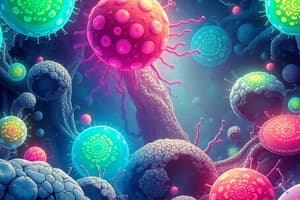Podcast
Questions and Answers
Which metabolic process uses an organic compound as both an electron donor and terminal electron acceptor?
Which metabolic process uses an organic compound as both an electron donor and terminal electron acceptor?
- Anaerobic respiration
- Aerobic respiration
- Fermentation (correct)
- Chemolithotrophy
The electron transport chain (ETC) is directly involved in the process of fermentation.
The electron transport chain (ETC) is directly involved in the process of fermentation.
False (B)
What is the primary purpose of oxidizing NADH during fermentation?
What is the primary purpose of oxidizing NADH during fermentation?
Redox balance
In lactic acid fermentation, glucose is converted into two molecules of ______.
In lactic acid fermentation, glucose is converted into two molecules of ______.
Match each fermentation type with its primary end products:
Match each fermentation type with its primary end products:
Which statement accurately describes the role of secondary fermentation in cheese production?
Which statement accurately describes the role of secondary fermentation in cheese production?
Aerobic respiration yields less energy than anaerobic respiration.
Aerobic respiration yields less energy than anaerobic respiration.
Name three electron acceptors, other than oxygen, that some prokaryotes use for anaerobic respiration.
Name three electron acceptors, other than oxygen, that some prokaryotes use for anaerobic respiration.
In the absence of oxygen, E. coli uses ______ to reduce nitrate to nitrite.
In the absence of oxygen, E. coli uses ______ to reduce nitrate to nitrite.
Match the following denitrification steps with their corresponding products:
Match the following denitrification steps with their corresponding products:
How does denitrification impact agriculture?
How does denitrification impact agriculture?
Geobacter uses nitrate as its primary electron donor in iron reduction.
Geobacter uses nitrate as its primary electron donor in iron reduction.
What metal do iron-reducing bacteria reduce, and what is the product of this reduction?
What metal do iron-reducing bacteria reduce, and what is the product of this reduction?
In sulfate reduction, sulfate ($SO_4^{2-}$) is reduced to ______ and then to hydrogen sulfide ($H_2S$).
In sulfate reduction, sulfate ($SO_4^{2-}$) is reduced to ______ and then to hydrogen sulfide ($H_2S$).
Match the type of sulfate reduction to its use:
Match the type of sulfate reduction to its use:
Which of the following describes the role of methanogens in anaerobic environments?
Which of the following describes the role of methanogens in anaerobic environments?
Chemolithotrophs use organic compounds as electron donors.
Chemolithotrophs use organic compounds as electron donors.
Name three inorganic electron donors used by chemolithotrophs.
Name three inorganic electron donors used by chemolithotrophs.
Most chemolithotrophs are ______, meaning they generate reducing power to fix carbon dioxide.
Most chemolithotrophs are ______, meaning they generate reducing power to fix carbon dioxide.
Match the following chemolithotrophic bacteria with their primary energy source:
Match the following chemolithotrophic bacteria with their primary energy source:
What is a key function of 'reverse electron flow' in iron-oxidizing bacteria such as Acidithiobacillus ferrooxidans?
What is a key function of 'reverse electron flow' in iron-oxidizing bacteria such as Acidithiobacillus ferrooxidans?
Nitrobacter oxidizes ammonia to nitrite.
Nitrobacter oxidizes ammonia to nitrite.
What is the role of the enzyme hydroxylamine oxidoreductase (HAO) in Nitrosomonas?
What is the role of the enzyme hydroxylamine oxidoreductase (HAO) in Nitrosomonas?
Elemental sulfur and sulfide are oxidized by bacteria like Thiobacillus into ______ and then into sulphate.
Elemental sulfur and sulfide are oxidized by bacteria like Thiobacillus into ______ and then into sulphate.
Match each characteristic with the appropriate type of phototrophy:
Match each characteristic with the appropriate type of phototrophy:
What is the primary role of phototrophy in microbial ecosystems?
What is the primary role of phototrophy in microbial ecosystems?
Anoxygenic phototrophs include cyanobacteria, algae, and plants.
Anoxygenic phototrophs include cyanobacteria, algae, and plants.
What molecule is split in oxygenic photosynthesis to supply electrons, and what is the byproduct?
What molecule is split in oxygenic photosynthesis to supply electrons, and what is the byproduct?
Most phototrophs are ______, using their generated energy to fix carbon dioxide.
Most phototrophs are ______, using their generated energy to fix carbon dioxide.
Match the descriptions with the correct terms:
Match the descriptions with the correct terms:
What role does reverse electron transport play in anoxygenic purple sulfur bacteria during photosynthesis?
What role does reverse electron transport play in anoxygenic purple sulfur bacteria during photosynthesis?
Anoxygenic green sulfur bacteria can fix carbon through the Calvin cycle.
Anoxygenic green sulfur bacteria can fix carbon through the Calvin cycle.
What light-harvesting structures are used by green sulfur bacteria?
What light-harvesting structures are used by green sulfur bacteria?
In oxygenic cyanobacteria, electrons are replaced by splitting ______, leading to the generation of oxygen.
In oxygenic cyanobacteria, electrons are replaced by splitting ______, leading to the generation of oxygen.
Match each role to its use in the Winogradsky column:
Match each role to its use in the Winogradsky column:
In a Winogradsky column, what gradient primarily drives the organization of microbial communities?
In a Winogradsky column, what gradient primarily drives the organization of microbial communities?
The Winogradsky column allows only aerobic organisms to grow.
The Winogradsky column allows only aerobic organisms to grow.
Name one product of sulfate-reducing bacteria that influences the chemistry and biology of the Winogradsky column.
Name one product of sulfate-reducing bacteria that influences the chemistry and biology of the Winogradsky column.
In a Winogradsky column, ______ bacteria are found in the aerobic zone, utilizing light energy to generate oxygen.
In a Winogradsky column, ______ bacteria are found in the aerobic zone, utilizing light energy to generate oxygen.
Flashcards
Fermentation
Fermentation
An energy source is the reductant and the terminal electron acceptor is the oxidant.
Anaerobic respiration
Anaerobic respiration
The final electron acceptor is an inorganic molecule other than oxygen.
Chemolithotrophy
Chemolithotrophy
Oxidizes reduced inorganic compounds for energy using electron transport chains.
Dissimilative sulfate reduction
Dissimilative sulfate reduction
Signup and view all the flashcards
Assimilative sulfate reduction
Assimilative sulfate reduction
Signup and view all the flashcards
Nitrate reductase in E. coli
Nitrate reductase in E. coli
Signup and view all the flashcards
Phototrophy
Phototrophy
Signup and view all the flashcards
Anoxygenic Purple Sulfur Bacteria
Anoxygenic Purple Sulfur Bacteria
Signup and view all the flashcards
Nitrification by Nitrosomonas
Nitrification by Nitrosomonas
Signup and view all the flashcards
Nitrification by Nitrobacter
Nitrification by Nitrobacter
Signup and view all the flashcards
Winogradsky column
Winogradsky column
Signup and view all the flashcards
Geobacter
Geobacter
Signup and view all the flashcards
Oxygenic phototrophy
Oxygenic phototrophy
Signup and view all the flashcards
Anoxygenic phototrophy
Anoxygenic phototrophy
Signup and view all the flashcards
Methanogenesis
Methanogenesis
Signup and view all the flashcards
Study Notes
Metabolic Diversity and Oxygen
- Chemotrophs use chemical compounds for energy.
- Chemoorganotrophs use organic electron donors
- Chemolithotrophs use inorganic electron donors.
- Fermentation, anaerobic, and aerobic respiration are processes influenced by electron donors and acceptors.
Fermentation
- An energy source acts as a reductant, while a terminal electron acceptor functions as an oxidant.
- An electron transport chain (ETC) is not involved.
- Provides a mechanism to oxidize NADH to maintain redox balance
- ATP is mainly produced through substrate-level phosphorylation.
- Products: ethanol, lactic acid, acetic acid, and H2
- Primary ATP source: some prokaryotes
- ATP source if respiration is not possible
Homofermentative Fermentation
- Lactobacillus spp, glucose is converted to two lactates with a net yield of 2 ATP
Heterofermentative Fermentation
- Lactobacillus spp, glucose is converted to lactate, ethanol + CO2
Mixed-Acid and Butanediol Fermentations
- E. coli uses mixed-acid fermentation
- E. aerogenes uses butanediol fermentations
- Pyruvate is a precursor in both pathways.
Fermentations by Obligate Anaerobes (Clostridia)
- Oxidation uses alanine, leucine, isoleucine, valine, or histidine
- Reduction uses glycine, proline, tryptophan or arginine
- Acetyl-CoA can derive ethanol and other byproducts like isopropanol or acetone
Secondary Fermentations and Swiss Cheese
- Fermentation products from one organism serve as the substrate for another,
- Propionibacterium, gives Emmental cheeses their flavor.
Anaerobic Respiration
- Uses electron transport chains with inorganic final electron acceptors.
- Energy yields are lower than aerobic respiration.
- Electron acceptors: Nitrate (NO3-), Ferric iron (Fe3+), Sulfate (SO42-), and CO2
Nitrate Reduction
- E. coli, in the absence of O2, uses nitrate reductase.
- Nitrate (NO3-) converts to nitrite (NO2-).
- Generates less PMF compared to using O2.
Denitrification
- Pseudomonads use nitrate reductase in the absence of O2.
- Nitrate (NO3-) is reduced to nitrite (NO2-), then to NO(g), N2O(g), and finally N2(g).
Denitrification - Beneficial and Detrimental Aspects
- Beneficial - important role in sewage treatment
- Detrimental - loss of fertilizer to the atmosphere, N2O is a greenhouse gas, NO reacts with ozone and water to form nitric acid (acid rain)
Iron-Reducing Bacteria
- Geobacter uses acetate as an electron donor with ferric iron oxides.
- Ferric iron (Fe3+) is reduced to ferrous iron (Fe2+).
- Can bioremediate of metal contamination such as uranium.
Sulfate Reduction
- Desulfovibrio uses organic compounds as electron donors with sulfates as electron acceptors.
- Sulfate (SO42-) is reduced to sulfite (SO32-) and then to sulfide (H₂S).
- If reduced sulfur makes organic sulfur compounds, it is assimilative sulfate reduction.
- If reduced sulfur is excreted, it is dissimilative sulfate reduction.
Methanogenesis (and Acetogenesis)
- Methanogens are anaerobic archaea
- CO2 converts to CH4 (methane) or CH3CO2 (acetate)
Chemolithotrophic Respiration
- Oxidation of reduced inorganic compounds for energy.
- Electron transport chains use inorganic electron donors to generate PMF.
- Electron donors: Ammonia (NH4+), Ferrous iron (Fe2+), Sulfide (H2S), and H2
- Oxygen (O2) is the final electron acceptor in aerobic lithotrophic respiration.
- Most are autotrophs which generate reducing power to fix CO2.
H2 Oxidation
- Ralstonia oxidizes dihydrogen to form water.
- Oxygen (O2) is the preferred electron acceptor; CO2 can also be used.
- Bacteria use H2 to generate NADH for the Calvin cycle.
Iron Oxidation
- Acidithiobacillus ferrooxidans oxidizes ferrous iron into ferric iron.
- Oxygen is the preferred electron acceptor, however, nitrate can be used
- Reverse electron flow is used to generate NADH for the Calvin cycle.
- Iron oxidizers are common in acidic aquatic environments.
Nitrification (Nitrosomonas)
- Ammonia converts to nitrite.
- Oxygen (O2) is the final electron acceptor.
- Uses reverse electron flow to make NADH for the Calvin cycle.
- Nitrifiers thrive in NH3-rich environments.
Nitrification (Nitrobacter)
- Nitrite converts to nitrate.
- Oxygen (O2) is the final electron acceptor.
- Reverse electron flow is used to generate NADH for the Calvin cycle.
- Commonly found in high NH3-rich environments
Sulfur Oxidizers (Thiobacillus)
- Elemental sulfur (S0) and sulfide (H2S) convert to sulphite and then sulphate.
- Oxygen (O2) is the preferred electron acceptor; nitrate can also be used.
- Bacteria use reverse electron flow is used to generate NADH for the Calvin cycle.
- “Colourless sulfur bacteria” are prevalent in hydrothermal vents and hot springs.
Phototrophy
- Light energy is the energy for electron flow.
- Electron transport chains generate PMF for use in photophosphorylation.
- Can be classified as oxygenic.
- Oxygenic phototrophy splits water to supply electrons, generating O2 (cyanobacteria, algae, protists, plants).
- Can be classified as anoxygenic.
- Anoxygenic phototrophy doesn't split water or form O2, exclusive to prokaryotes.
- Most phototrophs are autotrophs that to make reducing power to fix CO2.
Anoxygenic Purple Sulfur Bacteria
- Chromatium spp. use this process.
- Uses “Q-type” photosystems and cyclic electron flow to generate PMF.
- Oxidizes H2S and uses reverse electron transport to make reducing power.
- Elemental sulfur (S0) accumulates inside (periplasm) or outside the cells.
- Carbon-fixation occurs by the Calvin Cycle.
Anoxygenic Green Sulfur Bacteria
- Chlorobium spp. use this process.
- They use chlorosomes and a "FeS-type" photosystem.
- Cyclic electron flow may be used.
- Electrons are used to reduce ferredoxin, and are replenished by the oxidation of H2S to Sº to SO42-.
- Carbon-fixation goes through the reverse citric acid cycle.
Oxygenic Cyanobacteria (Prochlorococcus)
- Both "Q-type" and "FeS-type" reaction centres are present.
- Follows linear electron flow.
- Electrons generate PMF and reduce NAD(P)+.
- Oxidation of H2O to H2O replaces electrons.
- Carbon-fixation occurs through the Calvin Cycle.
Studying That Suits You
Use AI to generate personalized quizzes and flashcards to suit your learning preferences.




